Exploring the targets and molecular mechanism of glycyrrhetinic acid against diabetic nephropathy based on network pharmacology and molecular docking
2023-11-26FanDiMengLingYuanDuoJieXuMengYingCheShaoZhangHouDouDouLuWenJingLiuYiNan
Fan-Di Meng,Ling Yuan,Duo-Jie Xu,Meng-Ying Che,Shao-Zhang Hou,Dou-Dou Lu,Wen-Jing Liu,Yi Nan
Abstract BACKGROUND Diabetic nephropathy (DN) stands as the most prevalent chronic microvascular complication of diabetes mellitus.Approximately 50% of DN patients progress to end-stage renal disease,posing a substantial health burden.AIM To employ network pharmacology and molecular docking methods to predict the mechanism by which glycyrrhetinic acid (GA) treats DN,subsequently validating these predictions through experimental means.METHODS The study initially identified GA targets using Pharm Mapper and the TCMSP database.Targets relevant to DN were obtained from the Genecards,OMIM,and TTD databases.The Venny database facilitated the acquisition of intersecting targets between GA and DN.The String database was used to construct a protein interaction network,while DAVID database was used to conducted Kyoto Encyclopedia of Genes and Genomes (KEGG) pathway analysis and Gene Ontology (GO) analysis.Molecular docking experiments were performed using Autodock software with selected proteins.Experimental validation was conducted using renal proximal tubular cells (HK-2) as the study subjects.A hyperglycemic environment was simulated using glucose solution,and the effect of GA on cell viability was assessed through the cell counting kit-8 method.Flow cytometry was employed to detect cell cycle and apoptosis,and protein immunoblot (western blot) was used to measure the expression of proteins of the phosphatidylinositol 3-kinase (PI3K)/protein kinase B (AKT) signaling pathway and insulin resistance pathway,including insulin receptor (INSR),PI3K,p-PI3K,AKT,p-AKT,and glycogen synthase kinase-3 (GSK3).RESULTS A total of 186 intersecting targets between GA and DN were identified,which were associated with 144 KEGGrelated enrichment pathways,375 GO biological process entries,45 GO cellular component entries,and 112 GO cellular function entries.Molecular docking demonstrated strong binding of GA to mitogen-activated protein kinase (MAPK)-1,SRC,PIK3R1,HSP90AA1,CASPASE9,HARS,KRAS,and MAPK14.In vitro experiments revealed that GA inhibited HK-2 cell viability,induced cell cycle arrest at the G2/M phase,and reduced apoptosis with increasing drug concentration.Western blot analysis showed that GA differentially up-regulated GSK3 protein expression,up-regulated AKT/p-AKT expression,down-regulated INSR,AKT,p-AKT,PI3K,and p-PI3K protein expression,and reduced p-PI3K/PI3K levels under high glucose conditions.CONCLUSION GA may protect renal intrinsic cells by modulating the PI3K/AKT signaling pathway,thereby inhibiting HK-2 cell viability,reducing HK-2 cell apoptosis,and inducing cell cycle arrest at the G0/G1 phase.
Key Words: Network pharmacology;Molecular docking;Diabetic nephropathy;Glycyrrhetinic acid;Mechanism of action
lNTRODUCTlON
Diabetes mellitus (DM) is a prevalent condition characterized by either an absolute or relative deficiency in insulin secretion.In recent years,the incidence of DM has steadily increased due to the fast-paced nature of modern life,resulting in a rising number of DM cases since 1990[1].The functional unit of the kidney,known as the nephron,comprises renal corpuscles and tubules.The kidneys play a crucial role in filtering blood and generating urine through processes involving glomerular filtration and tubular reabsorption.Elevated glucose levels can lead to microvascular damage in the kidneys,resulting in structural and functional impairments,ultimately giving rise to diabetic nephropathy (DN).DN stands as the most prevalent chronic microvascular complication of DM,often characterized by proteinuria,making 24-h urine albumin measurement a key diagnostic modality.Approximately 50% of DN patients progress to endstage renal disease,posing a substantial health burden.Projections estimate that DN-related deaths will continue to rise,with an anticipated 224.2% increase,reaching 88803 deaths by 2030,as compared to 1990[2].Primary treatment approaches focus on blood sugar regulation and the enhancement of renal function.Commonly used clinical medications to improve renal blood circulation include angiotensin converting enzyme inhibitors and sulfonylureas.However,these drugs may exhibit varying degrees of side effects on other organs,underscoring the need for natural compounds with minimal side effects.Glycyrrhetinic acid (GA) is a metabolite of glycyrrhizic acid primarily processed by the liver,existing in both α and β forms.Initially employed for liver fibrosis treatment,GA’s medical utility has expanded to include various organ diseases,such as liver cancer and tumors.Studies have suggested that GA may safeguard glomeruli in diabetes by reducing transforming growth factor-β1 expression[3],mitigating podocyte injury[4],countering oxidative stress-induced glomerular mesangial cell hypertrophy and injury[5],and alleviating glomerular fibrosis.While the protective effect of GA on early to mid-stage renal fibrosis in kk-Ay diabetic mice has been demonstrated[6],no specific drug targets or molecular mechanisms have been conclusively identified.Therefore,this study delves into the microscopic perspective of GA to explore its specific drug targets and molecular mechanisms in DN.
DN involves a multifaceted mechanism of pathogenesis,encompassing factors beyond insulin resistance (IR) and glucose metabolism disorders.It encompasses altered hemodynamics,inflammatory responses,oxidative stress,autophagy,and exosomal processes.Researchers have explored various molecular mechanisms to address DN.For instance,Houet al[7] revealed that GA exerts preventive and therapeutic effects on DN by activating the kinase signaling pathway,specifically involving AMPK/SIRT1/PGC-1 (phosphorylated peroxisome proliferator-activated receptorcoactivator-1) in renal tissues.In a separate study,Ping-Ping Jia employed the Yi Qi,Nourishing Yin,and activating blood formula to mitigate inflammatory responses and reduce renal pathological injuries in DN rats.This was achieved by modulating the NLRP3/Caspase-1/GSDMD pathway,thus suppressing cellular pyroptosis[8].Additionally,Tanet al[9] suggested that glycyrrhizidine may confer protection against DN in rats by inhibiting ferroptosis and modulating the vascular endothelial-derived growth factor/protein kinase B (AKT)/extracellular signal-regulated kinase pathway[9].Interestingly,our exploration identified a research gap,as no prior studies had delved into the potential of GA as a therapeutic agent for DN treatment.Consequently,we elected to investigate this promising avenue.
Utilizing comprehensive databases such as PharmMapper,TCMSP,GeneCards,OMIM,and TTD,we meticulously searched for targets associated with both the drug GA and the disease DN.Subsequently,we identified common targets by taking their intersections.The pivotal target-pathway relationships were elucidated through a protein-protein interaction (PPI) network analysis.Furthermore,we conducted Gene Ontology (GO) and Kyoto Encyclopedia of Genes and Genomes (KEGG) enrichment analyses to gain deeper insights.Molecular docking studies were performed employing GA constituents to provide a comprehensive understanding of potential interactions.Finally,we executed experimental validations to furnish a novel reference method for the treatment of DN (refer to Figure 1).
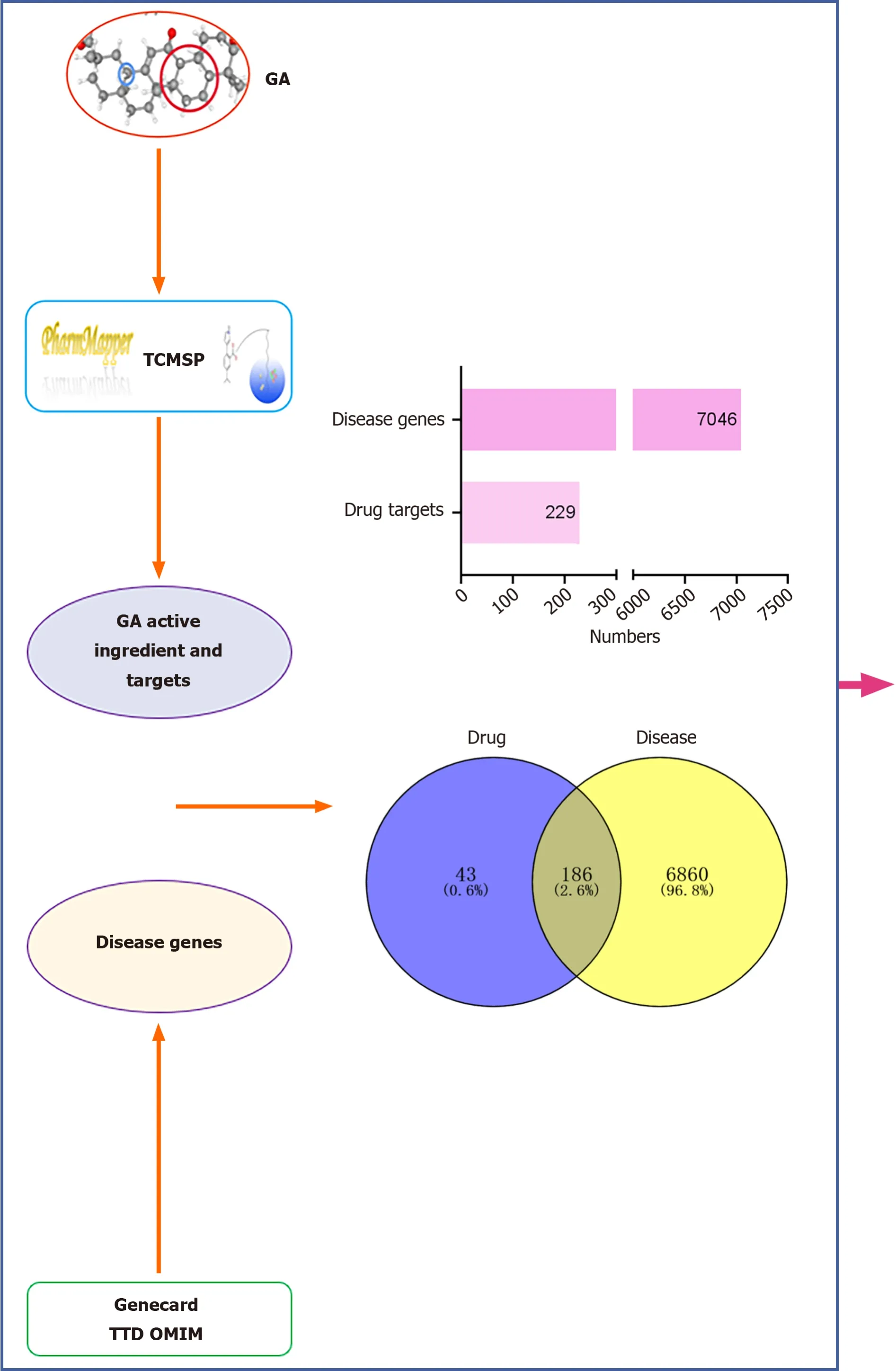
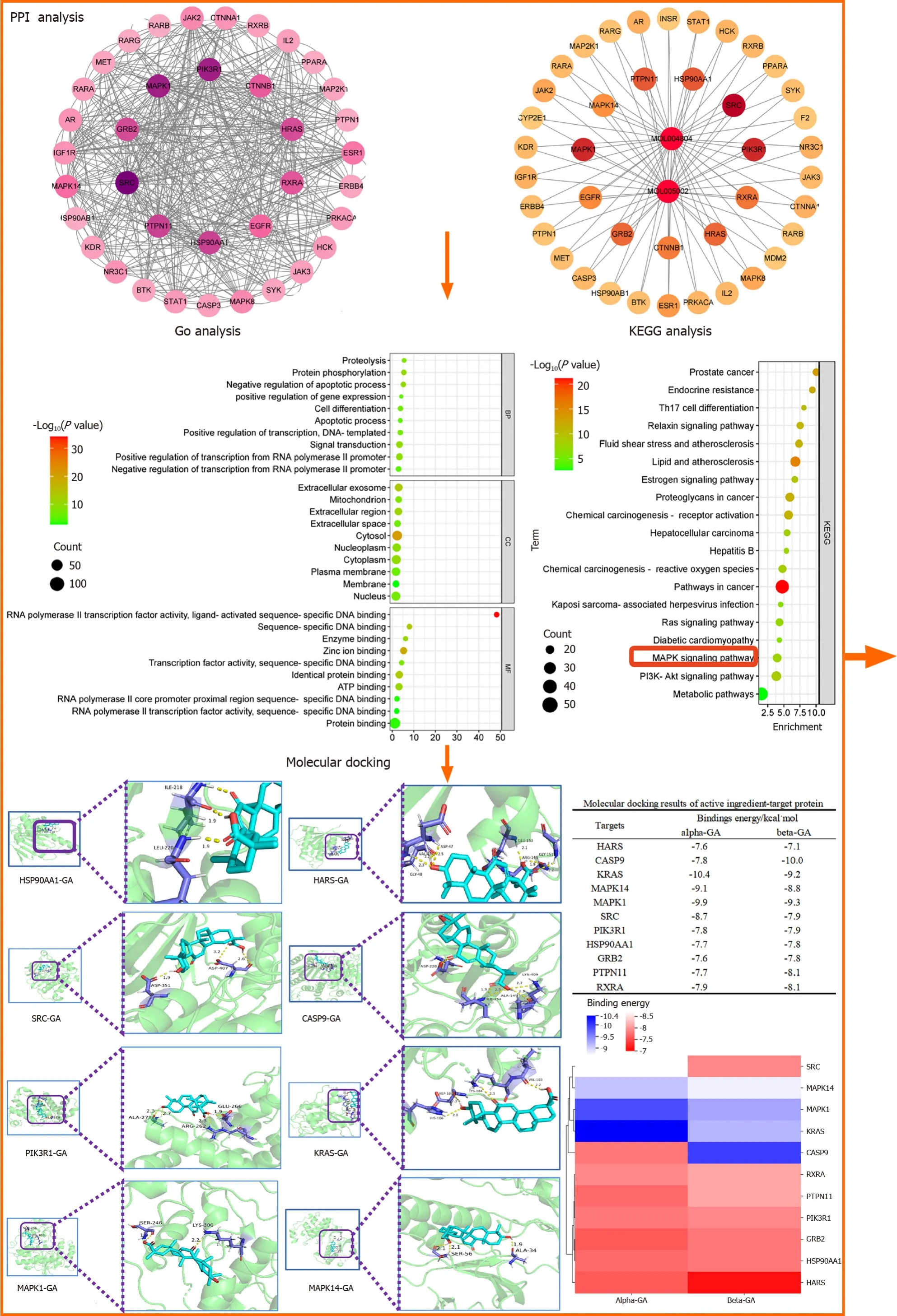
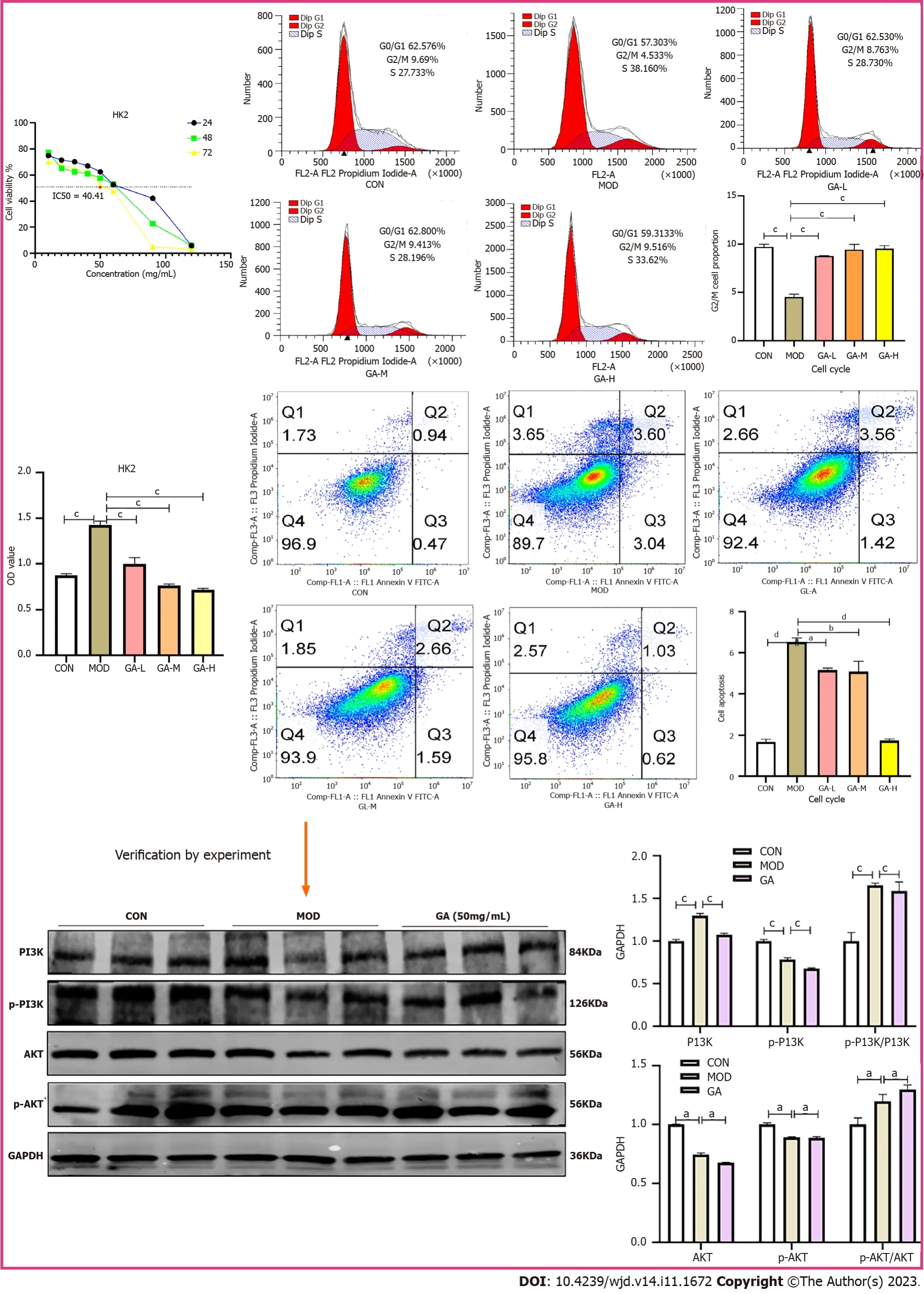
Figure 1 Graphical abstract summarizing the network pharmacological predictions and experimental validations. GA: Glycyrrhetinic acid;PPI: Protein-protein interaction;GO: Gene Ontology;KEGG: Kyoto Encyclopedia of Genes and Genomes.
MATERlALS AND METHODS
GA structure and target acquisition
The study harnessed a combination of databases and tools to establish connections between diseases and drugs based on gene networks.This approach allowed us to predict the potential efficacy of drugs in treating specific diseases,subsequently subjecting these predictions to verification.The relevant information was procured from the PubChem database (https://pubchem.ncbi.nlm.nih.gov/).Herein,the keywords “alpha-glycyrrhetinic acid” and “betaglycyrrhetinic acid” were employed to conduct searches,and the corresponding mol2 structure files for GA were duly downloaded.The acquisition of GA targets was executed by eliminating duplicates from datasets obtained from both the Pharm Mapper (http://www.lilab-ecust.cn/pharmmapper/) and TCMSP (https://old.tcmsp-e.com/tcmsp.php) databases.
Acquisition of DN targets
To identify targets associated with DN,searches were conducted in the GeneCards database (https://www.genecards.org/),OMIM database (https://www.genecards),and TTD database (https://www.genecards) using keywords such as “Diabetic Kidney Disease” and “Diabetic Nephropathy”.The OMIM database (https://omim.org/) and TTD database (http://db.idrblab.net/ttd/) were instrumental in locating these DN targets,and any duplications within the obtained target lists were thoughtfully eliminated.
Acquisition of common targets of GA and DN
Employing the Venny 2.1.0 platform (https://bioinfogp.cnb.csic.es/tools/venny/),we performed an intersection analysis on the target sets for GA and DN,thus identifying the common targets shared between them.
Construction of PPI network
The common targets of GA and DN were imported into the STRING11.5 database (https://cn.string-db.org/) to assemble a PPI network.During this process,“Homo sapiens” was designated as the biological species,and a minimum interaction threshold of “highest confidence” (> 0.9) was applied.Isolated nodes were concealed,while the default settings were maintained to generate the protein interaction diagram and associated data.Subsequently,the TSV file containing PPI information was extracted and introduced into Cytoscape software.Here,the network analyzer plug-in facilitated the analysis of network properties,allowing for the identification of core targets within the PPI network based on node degree.
Composition and target network diagram construction
The assembled targets and active components of GA were used to construct a dedicated network within Cytoscape software.Subsequently,the network analyzer plug-in was harnessed to scrutinize the network’s inherent characteristics,with a specific focus on the interaction between the active components of GA and the core targets,assessed based on node degrees.
GO and KEGG enrichment analysis
The shared targets of GA and DN underwent GO function and KEGG pathway enrichment analysis within the DAVID database (https://david.ncifcrf.gov/).The criteria for selection encompassed aP-value < 0.01 and false discovery rate < 0.01.Subsequently,the identified items meeting these criteria were visually presented using the Micro Bioinformatics platform (http://www.bioinformatics.com.cn/).
Construction of component-target network diagram pertaining to signal pathway
The core pathway targets obtained post-KEGG enrichment were incorporated into the STRING11.5 database to establish a comprehensive PPI network.The resultant TSV file,representing PPIs,was retrieved and imported into Cytoscape software.Employing the network analyzer plug-in,an intricate component-target network diagram pertaining to the pathway was meticulously reconstructed.This reconstruction illuminated the interactions between the active components of GA and the target components,with the degree value of nodes serving as a crucial determinant.
Molecular docking
To facilitate molecular docking,the 3D structures of core targets were obtained from the PDB database (https://www.rcsb.org/).The selection criteria ensured that the protein 3D structures originated from humans,possessed a conformational resolution of less than 2.5 A,encompassed complete protein conformation sequences,and included small molecular ligands.Furthermore,the crystallization pH value closely approximated the normal physiological pH of the human body and was stored in PDB format.Subsequently,Pymol software was utilised to eliminate water molecules and small molecular ligands from the proteins.AutoDock software was then introduced to facilitate the necessary hydrotreatment,followed by molecular docking,employing the mol2 structure of GA’s active ingredient.The resulting binding activity was subsequently evaluated.
Cell experiment verification
Cells:HK-2 cells (renal proximal tubular cells) were procured from Pronoxel (Catalog No.CL-0109).
Drugs and reagents:GA was obtained from Sigma Inc.(BCC0217;Table 1).
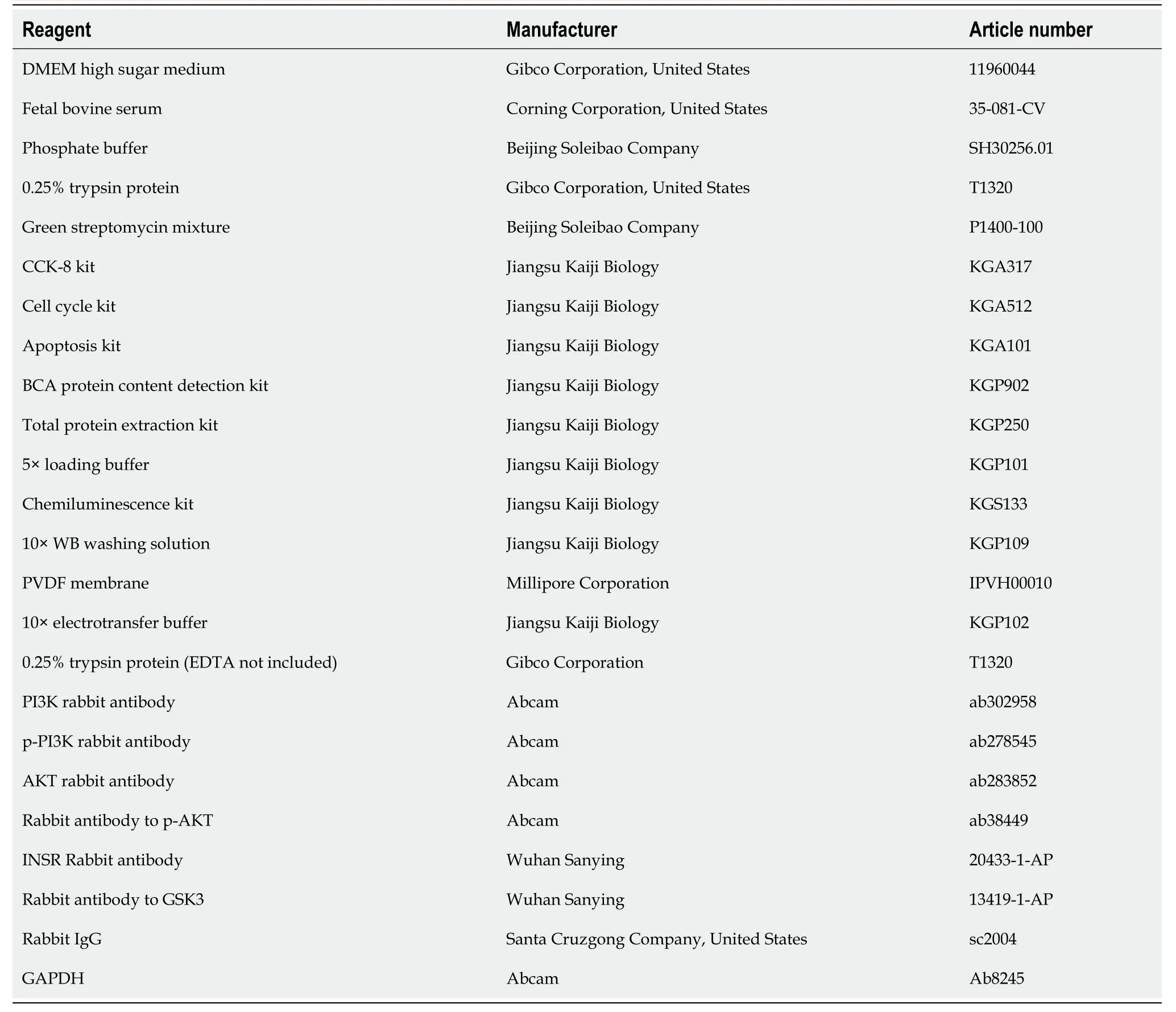
Table 1 Drugs and reagents
Cell culture:HK-2 cell cultivation involved the use of a complete medium comprising high-glucose DMEM,10% foetal bovine serum,and a 1% penicillin-streptomycin mixture.This cultivation took place within an incubator set at 37 °C with 5% CO2.The degree of growth confluence,typically reaching 70%-80%,was routinely observed under a microscope.
Determination of half inhibitory concentration of GA by cell counting kit-8 method:The determination of GA’s half inhibitory concentration (IC50) was carried out using the cell counting kit-8 (CCK-8) method.The WST-8 reagent in the CCK-8 kit can be reduced to produce orange formazan,and this transformation is linked to cell metabolic activity.Thus,CCK-8 can ascertain cell survival rates by measuring the concentration of formazan (http://keygentec.com.cn/uld/pdf/KGA317.pdf).In a previous study by Caoet al[10],the CCK-8 method revealed decreased cell viability in the ultrasound plus microbubble group.HK-2 cells in the logarithmic growth phase were subjected to trypsin digestion to prepare a cell suspension.These cells were counted using a 20 × microscope and subsequently divided into experimental groups.These groups included the control group (CON) (comprising complete cell culture medium),the model group (MOD) (consisting of 60 mmol/L high glucose culture medium),and the GA drug group.These cells were inoculated into 96-well plates at a density of 1 × 104cells per well,with each group having five replicate wells.The drug was diluted to varying concentrations based on a drug concentration gradient.The cells were treated for 24 h,48 h,and 72 h,respectively,with the addition of 100 μL of liquid to each well.Following the drug intervention,each well was incubated for 1 h with 10 μL of CCK-8 solution.The enzyme marker was activated,and the wavelength parameter was set to 450 nm to measure cell optical density (OD) for subsequent statistical analysis.
Detection of effect of GA on the cell cycle of HK-2 cells induced by high sugar by flow cytometry:The impact of GA on the cell cycle of HK-2 cells induced by high sugar was assessed through flow cytometry.HK-2 cells in the logarithmic growth phase were divided into five groups: The CON (cultured in complete cell culture medium),the MOD (grown in 60 mmol/L high-glucose culture medium),the low-dose group (cultivated in high-glucose culture medium+30 mg/mL GA),the medium-dose group (grown in high-glucose culture medium+40 mg/mL GA),and the high-dose group (cultivated in high-glucose culture medium+50 mg/mL GA).In each group,three samples were prepared and inoculated into 6-well plates at a density of 1 × 105cells per well.After 24 h of incubation in the culture,the cells were treated with serum-free medium for 12 h.Subsequently,each group received an additional 24 h of intervention.Cells were then digested and collected,followed by resuspension in pre-cooled 70% ethanol.After an overnight fixation,the cells were processed according to the cell cycle kit’s instructions.Proportions of cells in each cycle were measured using flow cytometry,and statistical analysis was conducted accordingly.
Determination of effect of GA on apoptosis of HK-2 cells induced by high glucose by flow cytometry:A total of five groups of logarithmically growing HK-2 cells,identical to those in the cell cycle experiment group,were analysed.Each group comprised three samples,and 1 × 105cells were inoculated per well in 6-well plates.Following 24 h of incubation in the culture,the corresponding culture medium was introduced to each group for a 24-h intervention period.After the cells were digested,collected,and processed using the apoptosis kit,flow cytometry was employed to detect the proportion of apoptosis for subsequent statistical analysis.
Detection of expression of insulin receptor,phosphatidylinositol 3-kinase,p-phosphatidylinositol 3-kinase,AKT,p-AKT,and glycogen synthase kinase-3 by Western blot:The expression of insulin receptor (INSR),phosphatidylinositol 3-kinase (PI3K),phosphorylated (p)-PI3K,AKT,p-AKT,and glycogen synthase kinase-3 (GSK-3) was assessed through western blot.HK-2 cells in the logarithmic growth phase were categorised into three groups: The CON,the MOD,and the high-dose group (50 mg/mL GA),each consisting of three samples.The cell intervention procedure remained consistent with the previous description.After cell digestion,1.5 mL EP tubes were utilised to collect cells for each group,with 100 μL of RIPA lysis buffer added to each tube.The subsequent steps followed the instructions of the total protein extraction kit (http://keygentec.com.cn/uld/fct/103761.pdf).Upon successful protein extraction,protein content was determined.Sodium dodecyl sulfate-polyacrylamide gel electrophoresis was conducted based on the protein’s quantitative results.Following TBST cleaning of the protein bands,they were subjected to rotation and sealing,and then incubated with primary antibodies diluted in TBST at 4 °C overnight.After 2 d,a 1-h incubation at room temperature was carried out,followed by a secondary antibody incubation for another hour.Subsequently,TBST cleaning was performed three times,and a luminescence solution was added for gel imaging.Image J software was used to measure the grey value of the obtained data,with statistical software employed for statistical analysis.
Statistical methods
Statistical analyses were conducted using GraphPad Prism 8.0 software,and intergroup comparisons were executedviaone-way analysis of variance.A significance level ofP< 0.05 indicated statistical significance.
RESULTS
GA structure and targets
The chemical composition of GA was ascertained through TCMSP.The structural data for the two GA subtypes were acquired from the PubChem database and downloaded in mol2 format (Table 2 and Figure 2).A total of 229 GA targets were identifiedviaPharm Mapper and TCMSP after eliminating duplicates.

Table 2 Drug active ingredient
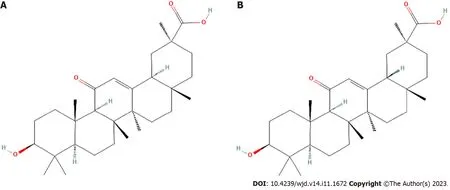
Figure 2 The structure of drug active ingredient. A: Beta-glycyrrhetinic acid;B: Alpha-glycyrrhetinic acid.
Targets of DN
After eliminating duplicate entries from the GeneCards,OMIM,and TTD databases,we obtained 7046 targets associated with DN.These targets were visualized and compared with the previously identified GA targets using GraphPad Prism (Figure 3A).
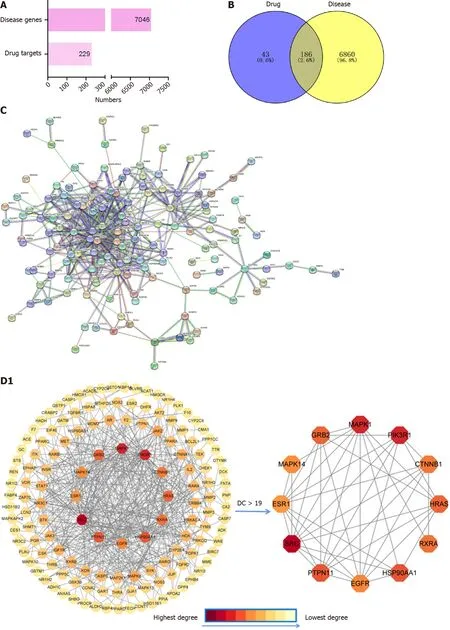
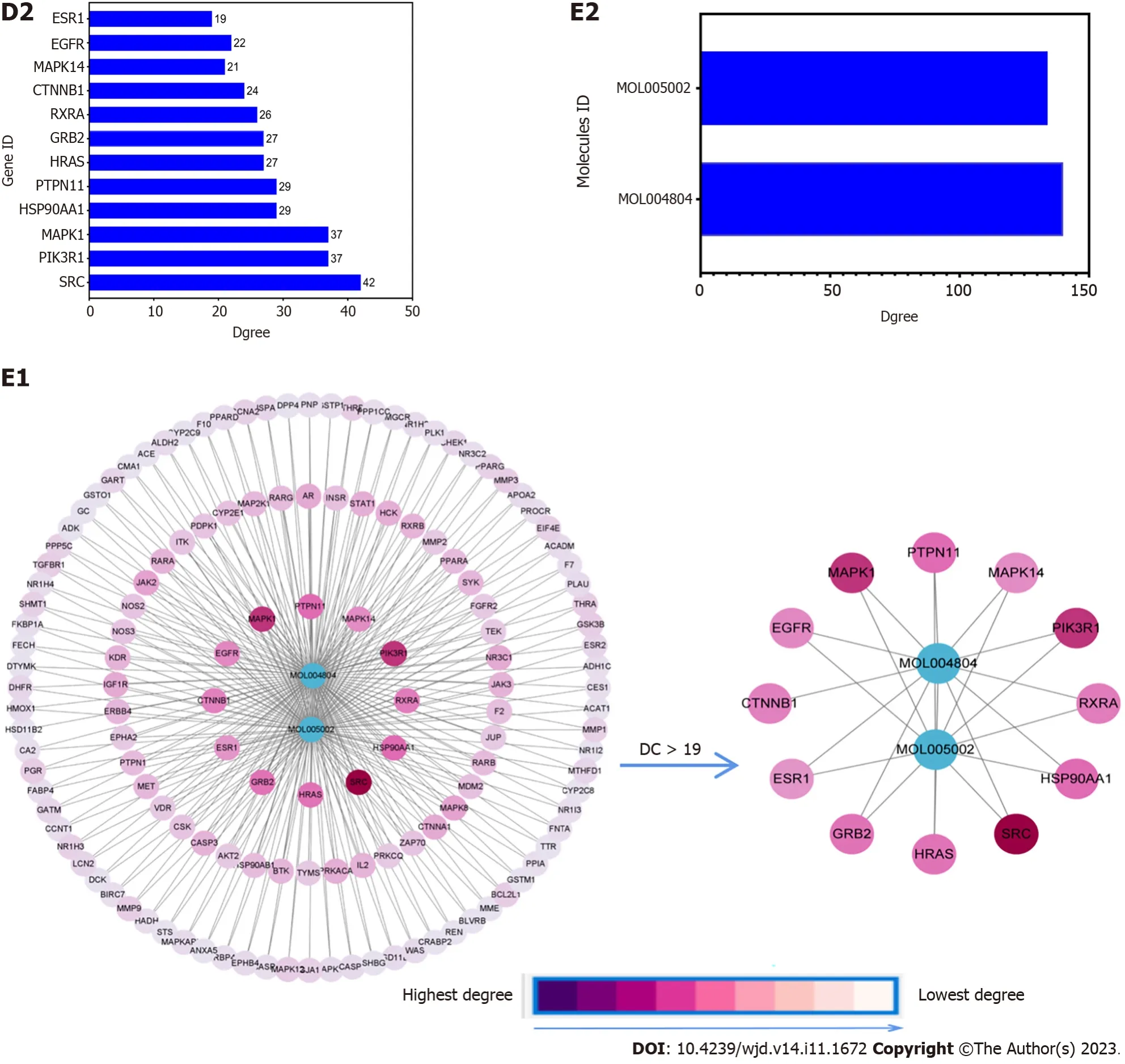
Figure 3 Targets and protein-protein interaction network enrichment analysis. A: Drug targets and disease genes;B: Intersection of drug and disease targets;C: Protein-protein interaction (PPI) network diagram of intersection genes between glycyrrhetinic acid (GA) and the disease;D: Utilization of Cytoscape to construct a PPI network comprising 186 common targets and 2 core targets for potential disease treatment;E: Analysis results of selected core targets and GA’s active components.Each node’s color denotes its degree.
Intersection of GA and DN targets
We employed the online tool Venny2.1.0 (https://bioinfogp.cnb.csic.es/tools/venny/) to create Venn diagrams that illustrated the intersection between the 229 potential GA targets and the 7046 DN targets.This analysis yielded 186 shared targets (Figure 3B).
Construction of PPI network diagram
The intersection targets of GA and DN were utilized to construct a PPI network diagram by accessing the STRING database (Figure 3C).This network consisted of 186 nodes and 511 edges,with each node representing a specific protein.
PPI network analysis
The PPI network diagram was analyzed using the network analyzer plug-in in Cytoscape,leading to the identification of 141 targets from the TSV file.Based on topological analysis results,we identified core targets for GA treatment of DN as nodes with a degree median greater than 19.These core targets included mitogen-activated protein kinase (MAPK)-1,SRC,PIK3R1,HSP90AA1,PTPN11,HRAS,GRB2,RXRA,MAPK14,and epidermal growth factor receptor (EGFR),among others.The results were visualized using software tools such as GraphPad Prism and Cytoscape (Figure 3D).
Component-target network analysis
We established a network diagram connecting the selected PPI targets with the active components of GA.Through network analyzer plug-in analysis in Cytoscape software,we revealed interactions between the two active GA components and 141 common targets,along with degree values for each target.Notably,targets such as MAPK-1,SRC,PIK3R1,HSP90AA1,HRAS,GRB2,and EGFR,among others,were identified,and the results are visually presented (Figure 3E).The shading of nodes in the figure corresponds to the degree median,with darker colors indicating higher median values.
GO and KEGG enrichment analysis
The GO enrichment analysis revealed 375 entries pertaining to biological processes,with significant involvement in processes such as signal transduction,transcriptional regulation from the RNA polymerase II promoter,phosphorylation of proteins,and the regulation of apoptosis.Additionally,45 cellular component items were identified,encompassing cellular locations such as cytosol,cytoplasm,nucleus,plasma membrane,and extracellular exosomes.Molecular function entries numbered 112,predominantly featuring functions related to protein binding and sequence-specific DNA binding.The first ten enriched results from each group are graphically represented (Figure 4A).The KEGG pathway enrichment analysis unveiled 90 enriched pathways,with notable involvement in signaling pathways such as PI3K/AKT,proteoglycans in cancer,and MAPK.Notably,the pathway associated with diabetic cardiomyopathy emerged as potentially significant in GA’s treatment of DN.The initial 20 enrichment results are depicted graphically (Figure 4B).For the construction of the component-target network map within the signaling pathway,network analyzer from STRING11.5 and Cytoscape software were utilised,incorporating GA’s active components.This analysis yielded core targets including MAPK-1,SRC,PIK3R1,HSP90AA1,HRAS,GRB2,and EGFR,among others,with the results visually presented (Figure 4C).The signaling pathway itself is also visualised (Figure 4D).
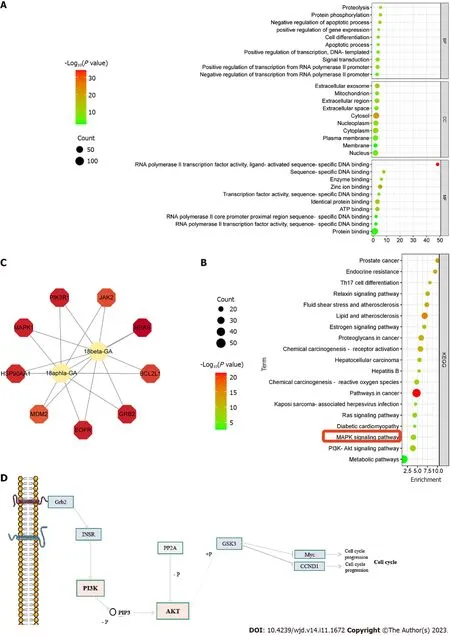
Figure 4 Gene Ontology and Kyoto Encyclopedia of Genes and Genomes analysis. A: Results of Gene Ontology enrichment analysis;B: Enrichment outcomes for Kyoto Encyclopedia of Genes and Genomes pathways;C: Expression results of enriched core genes within the phosphatidylinositol 3-kinase (PI3K)/protein kinase B (AKT) signaling pathway;D: Correlation between the PI3K/AKT signaling pathway and the cell cycle.
Molecular docking
The identified targets,namely,GASRC,MAPK1,PIK3R1,HSP90AA1,PTPN11,HRAS,GRB2,RXRA,MAPK14,and EGFR,underwent rigorous molecular docking analysis using Pymol software.The docking results are thoughtfully visualised and presented (Figure 5A).The assessment of binding activity was meticulously carried out,considering docking scores as the primary indicator.Notably,scores falling below -4.25 kcal/mol signified a certain level of binding activity,while scores less than -5.0 kcal/mol indicated strong binding activity.Visual representation of the binding activity between GA’s active components and target proteins is facilitated (Figure 5B),employing the ChiPlot online tool for comprehensive visualization output (Figure 5C).It is noteworthy that the binding energy observed between GA’s active components and the top 10 core target proteins consistently exceeded -5.0 kcal/mol,with KRAS-GA displaying the most favourable binding energy,registering at -10.4 kcal/mol.
Half inhibitory concentration of GA
Optical density values were recorded at three distinct time points: 24 h,48 h,and 72 h.These values were then utilised in the calculation formula for inhibition rates.Subsequently,the IC50values for HK-2 cells at each time point were calculated through fitting procedures employing Graphd Prism 8.0 software (Figure 6A).Notably,the experimental data indicated that after 72 h of drug intervention,the cell growth curves generated with the software closely approximated logarithmic curves.Therefore,the 72-h mark was chosen as the optimal duration for drug intervention.The calculated IC50value at this time point was determined to be 40.41 mg/mL,subsequently rounded to 40 mg/mL.In the context of CCK-8-based viability assessment of HK-2 cells across various groups,noteworthy trends emerged: The MOD displayed significantly enhanced viability compared to the CON (P< 0.05).Furthermore,cell viability exhibited a substantial increase (P< 0.01) when compared to the CON.Conversely,HK-2 cell viability exhibited a noteworthy decrease upon GA intervention (P< 0.01) relative to the MOD.This reduction in viability displayed a dose-dependent relationship,signifying that higher doses of GA yielded more pronounced decreases in HK-2 cell viability (Figure 6B).
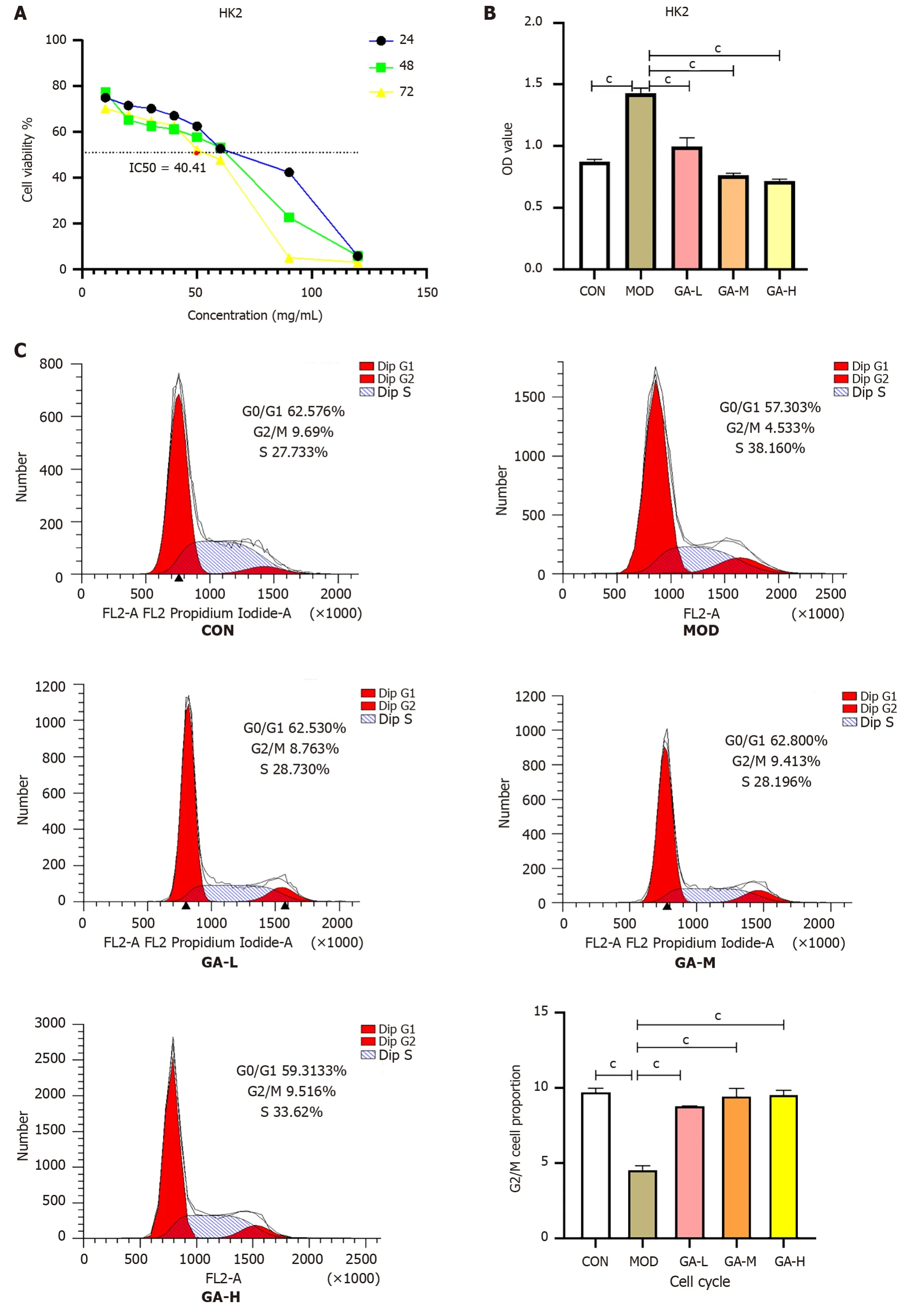
Figure 6 Determination of lC50,cell cycle,and apoptosis. A: Impact of glycyrrhetinic acid (GA) on the IC50 of HK-2 cells;B: Influence of GA on the activity of HK-2 cells;C: Effect of GA on the cell cycle of HK-2 cells;D: Effect of GA on apoptosis of HK-2 cells.The sequence from left to right represents the control group,the model group,and the GA group.aP < 0.05,bP < 0.01,cP < 0.001,dP < 0.0001.GA: Glycyrrhetinic acid;CON: Control;MOD: Model.
Effect of GA on cell cycle of HK-2 cells induced by high glucose
Following a 24-h exposure to GA,flow cytometry analysis was conducted to ascertain the impact of GA on the cell cycle of HK-2 cells.In comparison to the CON,the MOD exhibited a reduced proportion of cells in the G0/G1 phase (P< 0.01),with a concurrent increase in the proportion of cells in the G2/M and S phases (P< 0.01).Remarkably,GA intervention led to a higher proportion of cells in the G0/G1 phase and G2/M phase (P< 0.01) when compared to the MOD.These results underscore GA’s ability to arrest HK-2 cells in the G2/M phase (Figure 6C;CON 9.693 ± 0.506,MOD 4.533 ± 0.487,GA-L 8.763 ± 0.085,GA-M 9.413 ± 0.964,and GA-H 9.517 ± 0.557).
Effect of GA on apoptosis of HK-2 cells induced by high glucose
Following a 24-h exposure to GA,apoptosis of HK-2 cells was assessed using AV-PI double staining coupled with flow cytometry.Relative to the CON,the MOD exhibited a substantial increase in the percentage of apoptotic HK-2 cells (P< 0.01).In contrast,the GA dose groups displayed a notable reduction in the percentage of apoptosis when compared to the MOD (P< 0.01).This observed decrease in HK-2 cell apoptosis was particularly pronounced with increasing concentrations of GA (Figure 6D;CON 1.6733 ± 0.228,MOD 6.537 ± 0.327,GA-L 5.163 ± 0.172,GA-M 5.08 ± 0.878,and GA-H 1.747 ± 0.119).
Expression of INSR, PI3K, p-PI3K, AKT, p-AKT, and GSK-3 detected by western blot
Western blot analysis was employed to assess the protein expression levels of INSR,PI3K,p-PI3K,AKT,p-AKT,and GSK-3 in HK-2 cells after exposure to GA.The results revealed an up-regulation in the protein expression of INSR and PI3K,along with increased p-PI3K/PI3K and AKT/p-AKT ratios in the MOD when compared to the CON.Conversely,the expression levels of AKT,p-AKT,p-PI3K,and GSK3 proteins were down-regulated in the MOD.Subsequent to GA intervention,we observed an up-regulation in the expression of GSK3 protein,as well as elevated AKT/p-AKT and p-PI3K/PI3K ratios (P< 0.01 orP< 0.05).Conversely,the protein expression of INSR,AKT,p-AKT,PI3K,and p-PI3K was down-regulated,with a decrease in p-PI3K/PI3K expression (P< 0.01 orP< 0.05) (Figure 7).
DlSCUSSlON
Within the realm of Chinese medicinal and edible products,licorice,a staple of traditional Chinese medicine,holds a prominent position for its efficacy in treating digestive disorders.As is widely acknowledged,the advanced stages of DN,particularly the uremia stage,are often accompanied by distressing gastrointestinal symptoms such as vomiting and diarrhea.These symptoms arise in part due to the accumulation of peptides and guanidine compounds within the body.
In light of this,our focus turned to the natural herb licorice.The primary bioactive constituent within licorice is glycyrrhizic acid,which undergoes hepatic metabolism to yield GA.Notably,GA exhibits anti-inflammatory,antiviral,anticancer,anti-cardiovascular disease,and antioxidant properties[6,11-14].Given its multifaceted therapeutic potential,we selected GA as a candidate to predict its potential targets in the context of DN and subsequently validated these predictions throughin vitrocellular assays.
This study delves into the mechanistic insights into GA’s effects on DN,employing a network pharmacology approach.We identified a total of 186 GA targets associated with DN therapeutic effects.Utilizing a combination of GO analysis,KEGG analysis,and network interaction software,we revealed that GA may exert its influence on DN through the PI3K/AKT signaling pathway.Our predictions were substantiatedvia in vitrocellular experiments,where GA demonstrated a significant ability to inhibit the proliferation of HK-2 cells.Furthermore,it induced cell cycle arrest in the G2/M phase and resulted in a dose-dependent reduction in apoptosis in HK-2 cells.Western blot analysis unveiled that GA intervention led to the upregulation of p-AKT and GSK3 protein expression,with a concurrent increase in p-AKT/AKT ratio.Conversely,it downregulated the expression of INSR,AKT,PI3K,and p-PI3K proteins,along with decreased p-PI3K/PI3K ratio.These findings suggest that GA may hold promise in the treatment of DN by modulating the PI3K/AKT signaling pathway.
The PI3K/AKT signaling pathway assumes a pivotal role in insulin signaling[14].PI3K initiates the activation of AKT,subsequently engaging the phosphorylated and activated AKT in a cascade of cellular processes including apoptosis,protein synthesis,metabolism,and inflammation.It orchestrates intracellular signal transduction and modulates insulin receptor substrate,thereby exerting a regulatory influence on insulin signal transduction.This can lead to IR,a condition implicated in the development of DN.Furthermore,within the diabetic milieu,the PI3K/AKT pathway is activated in renal tubule cells,governing cellular growth,epithelial-interstitial transitions,and lipid metabolism[15].As a downstream messenger of PI3K/AKT,insulin receptor activation by receptor tyrosine kinase triggers substrate phosphorylation,activating PI3K.Subsequently,the activated AKT mediates cell proliferation,differentiation,and apoptosis by modulating a constellation of signaling molecules,including GSK3 and mechanistic target of rapamycin[16-18].It mitigates the deleterious impact of elevated glucose levels on rat mesangial cells,ameliorates oxidative stress responses,reduces renal parenchymal cell damage,and enhances kidney function.Notably,compound Zhengjiao lipid regulating capsules have been demonstrated to effectively lower fasting glucose levels,urinary protein excretion,and creatinine in DN mice.This is achieved through the inhibition of the PI3K/AKT and STAT3 signaling pathways[19].The therapeutic efficacy of Liuwei Dihuang Decoction in DN is linked to its ability to modulate glucose absorption,glycogen degradation,and synthesisviathe PI3K/AKT signaling pathway[20].Other investigations have underscored the potential of Tripterygium wilfordii-Gualsanthis Decoction in treating DN.This herbal remedy achieves its protective effects on renal intrinsic cells by inhibiting AKT activity,improving IR,curbing inflammation,and mitigating oxidative stress[21].Furthermore,GA demonstrates the capacity to stimulate lipolysis through the activation of the PI3K/AKT/HSL pathways,reduce fatty acid synthesis,and regulate lipid metabolism by down-regulating the sregbp-1c/FAS/SCD1 pathway[22].Consequently,these effects impinge upon glucose uptake,insulin secretion,diabetic vascular dysfunction,as well as the development of retinopathy and nephropathy[23].In our experimental setup,we induced IR in HK-2 cells through high glucose exposure,followed by intervention with varying GA concentrations.Our findings revealed that GA effectively arrested HK-2 cells in the G2/M phase,underscoring its regulatory role in cell cycle progression from the late stage of DNA synthesis to mitosis completion in HK-2 cells.Moreover,GA resulted in a dose-dependent reduction in apoptosis among HK-2 cells.These effects were accompanied by a potential upregulation of GSK3 protein expression.Simultaneously,downregulation of INSR,AKT,PI3K,and p-PI3K proteins hinted at GA’s capacity to activate or restore the impaired PI3K/AKT signaling pathway in a high-glucose environment.This cascade of events led to decreased fatty acid synthesis,reduced glucose absorption,lowered insulin secretion,and other pertinent biological processes,ultimately conferring a protective effect on human renal cortex proximal tubular epithelial cells exposed to high glucose conditions.
CONCLUSlON
In summary,GA appears to modulate the PI3K/AKT signaling pathway,resulting in the inhibition of HK-2 cell proliferation and a reduction in HK-2 cell apoptosis.It also induces a G2/M phase arrest while upregulating GSK3 and p-AKT expression,and downregulating AKT,PI3K,and p-PI3K proteins (Figure 8).These actions potentially involve the reactivation or restoration of the impaired PI3K/AKT pathway in the presence of hyperglycemia,thereby affording protection to renal parenchymal cells.Subsequently,we plan to conduct genetic testing using high-throughput validation techniques such as whole transcriptome analysis,methylation studies,and acetylated proteome analysis.Gene silencing or overexpression experiments targeting the core genes will be employed to verify whether the predicted targets serve as viable drug targets.Additionally,we will perform pathway validation by employing transcriptional and translational inhibitors targeting upstream and downstream signaling proteins.Furthermore,experimental techniques including the assessment of transcription factors and DNA binding through dual luciferase assays and chromatin immunoprecipitation will be utilized to delve deeper into the therapeutic mechanism of GA in the context of DN.
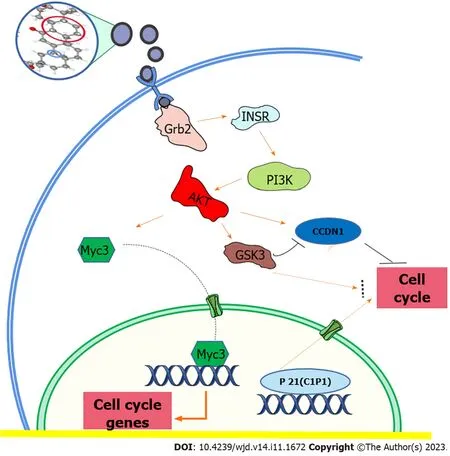
Figure 8 Diagram of the effect of glycyrrhetinic acid on the Pl3K/AKT signaling pathway. GSK3: Glycogen synthase kinase-3;INSR: Insulin receptor.
ARTlCLE HlGHLlGHTS
Research background
The prognosis of diabetes nephropathy is poor.Its pathological changes are chronic progressive damage.The clinical symptoms appear late.Once there is persistent proteinuria,its renal function will inevitably decline and develop into end-stage renal failure,causing a huge health burden.
Research motivation
We executed experimental validations to furnish a novel reference method for the treatment of DN.
Research objectives
This study employed network pharmacology and molecular docking methods to predict the mechanism by which glycyrrhetinic acid (GA) treats DN,subsequently validating these predictions through experimental means.
Research methods
Utilizing comprehensive databases such as PharmMapper,TCMSP,GeneCards,OMIM,and TTD,we meticulously searched for targets associated with both the drug GA and the disease DN.Subsequently,we identified common targets by taking their intersections.The pivotal target-pathway relationships were elucidated through a protein-protein interaction network analysis.Furthermore,we conducted Gene Ontology and Kyoto Encyclopedia of Genes and Genomes enrichment analyses to gain deeper insights.Molecular docking studies were performed employing GA constituents to provide a comprehensive understanding of potential interactions.
Research results
In summary,GA appears to modulate the phosphatidylinositol 3-kinase (PI3K)/protein kinase B (AKT) signaling pathway,resulting in the inhibition of HK-2 cell proliferation and a reduction in HK-2 cell apoptosis.It also induces a G2/M phase cell cycle arrest while upregulating glycogen synthase kinase-3 and p-AKT expression,and downregulating AKT,PI3K,and p-PI3K proteins.These actions potentially involve the reactivation or restoration of the impaired PI3K/AKT pathway in the presence of hyperglycemia,thereby affording protection to renal parenchymal cells.
Research conclusions
This study found 186 therapeutic targets for DN with GA,and GA may act on DN through the PI3K/AKT signaling pathway.The results ofin vitrocell experiments indicate that GA inhibits the proliferation of HK2 cells,blocks the cell cycle in the G2/M phase,and reduces the apoptosis of HK2 cells.GA can activate or restore the activity of the PI3K/AKT pathway damaged under high glucose conditions,thereby protecting inherent kidney cells.
Research perspectives
We plan to conduct genetic testing using high-throughput validation techniques.Gene silencing or overexpression experiments targeting the core genes will be employed to verify whether the predicted targets serve as viable drug targets.Additionally,we will perform pathway validation by employing transcriptional and translational inhibitors targeting upstream and downstream signaling proteins.Furthermore,experimental techniques including the assessment of transcription factors and DNA binding through dual luciferase assays and chromatin immunoprecipitation will be utilized to delve deeper into the therapeutic mechanism of GA in the context of DN.
FOOTNOTES
Author contributions:Meng FD,Yuan L,Xu DJ,Che MY,Hou SZ,and Lu DD designed the study;Meng FD,Yuan L,Lu DD,and Yi Nan conducted the study;Che MY and Hou SZ contributed new reagents and analytical tools;Meng FD,Yuan L,and Xu DJ analyzed the data and wrote the manuscript;and all authors have read and approved the final manuscript.
Supported byNingxia Natural Science Foundation,No.2022AAC02039;National Natural Science Foundation of China,No.81860894,82260879,and 81 674096;Ningxia Innovation Team of the Foundation and Clinical Researches of Diabetes and its Complications,No.NXKJT2019010.
lnstitutional review board statement:The study was reviewed and approved by the Medical Ethics Review Committee of Ningxia Medical University (No.2018-144).
Conflict-of-interest statement:All the authors report no relevant conflicts of interest for this article.
Data sharing statement:Technical appendix,statistical code,and dataset available from the corresponding author at 20080011@nxmu.edu.cn.Participants gave informed consent for data sharing.
Open-Access:This article is an open-access article that was selected by an in-house editor and fully peer-reviewed by external reviewers.It is distributed in accordance with the Creative Commons Attribution NonCommercial (CC BY-NC 4.0) license,which permits others to distribute,remix,adapt,build upon this work non-commercially,and license their derivative works on different terms,provided the original work is properly cited and the use is non-commercial.See: https://creativecommons.org/Licenses/by-nc/4.0/
Country/Territory of origin:China
ORClD number:Fan-Di Meng 0009-0009-9757-5815;Ling Yuan 0000-0003-2838-0976;Duo-Jie Xu 0009-0000-8992-4688;Meng-Ying Che 0009-0002-7560-1719;Shao-Zhang Hou 0000-0002-9794-8396;Dou-Dou Lu 0009-0009-4644-9181;Wen-Jing Liu 0000-0002-2934-6182;Yi Nan 0000-0002-5511-9266.
S-Editor:Wang JJ
L-Editor:Wang TQ
P-Editor:Yu HG
杂志排行
World Journal of Diabetes的其它文章
- Cellular and molecular overview of gestational diabetes mellitus: ls it predictable and preventable?
- Molecular targets and mechanisms of Jiawei Jiaotai Pill on diabetic cardiomyopathy based on network pharmacology
- Vascular endothelial growth factor B improves impaired glucose tolerance through insulin-mediated inhibition of glucagon secretion
- Reduced risk of dementia in patients with type 2 diabetes mellitus using Chinese herbal medicine: A nested case-control study
- Molecular mechanisms of noncoding RNA and epigenetic regulation in obesity with consequent diabetes mellitus development
- Mechanisms of action of natural products on type 2 diabetes
